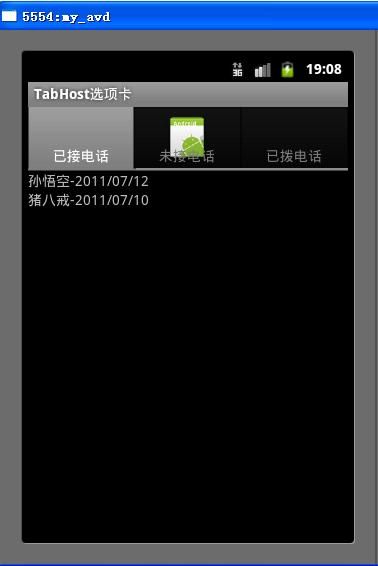Android之TabHost布局
http://www.cnblogs.com/devinzhang/archive/2012/01/18/2325887.html
1.概念
盛放Tab的容器就是TabHost。TabHost的实现有两种方式:
第一种继承TabActivity,从TabActivity中用getTabHost()方法获取TabHost。各个Tab中的内容在布局文件中定义就行了。
第二种方式,不继承TabActivity,在布局文件中定义TabHost即可,但是TabWidget的id必须是@android:id/tabs,FrameLayout的id必须是@android:id/tabcontent。
2.案例
1)继承TabActivity
res/layout/main.xml
<?xml version="1.0" encoding="utf-8"?> <!-- 定义TabHost组件 --> <TabHost xmlns:android="http://schemas.android.com/apk/res/android" android:layout_width="fill_parent" android:layout_height="fill_parent"> <!-- 定义第一个标签页的内容 --> <LinearLayout android:id="@+id/tab01" android:orientation="vertical" android:layout_width="fill_parent" android:layout_height="fill_parent"> <!-- 定义两个TextView用于显示标签页中的内容 --> <TextView android:layout_width="fill_parent" android:layout_height="wrap_content" android:text="孙悟空-2011/07/12"/> <TextView android:layout_width="fill_parent" android:layout_height="wrap_content" android:text="猪八戒-2011/07/10"/> </LinearLayout> <!-- 定义第二个标签页的内容 --> <LinearLayout android:id="@+id/tab02" android:orientation="vertical" android:layout_width="fill_parent" android:layout_height="fill_parent"> <TextView android:layout_width="fill_parent" android:layout_height="wrap_content" android:text="萨僧-2011/07/11"/> <TextView android:layout_width="fill_parent" android:layout_height="wrap_content" android:text="唐僧-2011/07/10"/> </LinearLayout> <!-- 定义第三个标签页的内容 --> <LinearLayout android:id="@+id/tab03" android:orientation="vertical" android:layout_width="fill_parent" android:layout_height="fill_parent"> <TextView android:layout_width="fill_parent" android:layout_height="wrap_content" android:text="孙悟空-2011/07/12"/> <TextView android:layout_width="fill_parent" android:layout_height="wrap_content" android:text="萨僧-2011/07/08"/> </LinearLayout> </TabHost>HelloTabHost.java
public class HelloTabHost extends TabActivity {
@Override
public void onCreate(Bundle savedInstanceState) {
super.onCreate(savedInstanceState);
//调用TabActivity的getTabHost()方法获取TabHost对象
TabHost tabHost = getTabHost();
//设置使用TabHost布局
LayoutInflater.from(this).inflate(R.layout.main, tabHost.getTabContentView(),true);
//添加第一个标签页
tabHost.addTab(tabHost.newTabSpec("tab01").setIndicator("已接电话").setContent(R.id.tab01));
//添加第二个标签页,并在其标签上添加一个图片
tabHost.addTab(tabHost.newTabSpec("tab02").setIndicator("未接电话",getResources().getDrawable(R.drawable.icon)).setContent(R.id.tab02));
//添加第三个标签页
tabHost.addTab(tabHost.newTabSpec("tab03").setIndicator("已拨电话").setContent(R.id.tab03));
}
}运行效果:
2)不继承TabActivity
继承普通Activity,<TabWidget>标签id必须为tabs、<FrameLayout>标签id必须为tabcontent.这个方式在通过findViewById获得TabHost之后,必须要调用setup方法。
main.xml代码
<?xml version="1.0" encoding="utf-8"?>
<!-- TabHost必须包含一个 TabWidget和一个FrameLayout-->
<TabHost android:id="@+id/tabhost" android:layout_width="fill_parent" android:layout_height="wrap_content">
<LinearLayout android:orientation="vertical" android:layout_width="fill_parent" android:layout_height="fill_parent">
<!-- TabWidget的id属性必须为 @android:id/tabs-->
<TabWidget android:id="@android:id/tabs" android:orientation="horizontal" android:layout_width="fill_parent"
android:layout_height="wrap_content" />
<!-- FrameLayout的id属性必须为 @android:id/tabcontent-->
<FrameLayout android:id="@android:id/tabcontent" android:layout_width="fill_parent" android:layout_height="fill_parent">
<TextView android:id="@+id/view1" android:layout_width="fill_parent" android:layout_height="fill_parent"/>
<TextView android:id="@+id/view2" android:layout_width="fill_parent" android:layout_height="fill_parent"/>
<TextView android:id="@+id/view3" android:layout_width="fill_parent" android:layout_height="fill_parent"/>
</FrameLayout>
</LinearLayout>
</TabHost>
</LinearLayout>Java代码
public class TabHostTest extends Activity {
@Override
public void onCreate(Bundle savedInstanceState) {
super.onCreate(savedInstanceState);
setContentView(R.layout.main);
// 获取TabHost对象
TabHost tabHost = (TabHost) findViewById(R.id.tabhost);
// 如果没有继承TabActivity时,通过该种方法加载启动tabHost
tabHost.setup();
tabHost.addTab(tabHost.newTabSpec("tab1").setIndicator("第一个标签",
getResources().getDrawable(R.drawable.icon)).setContent(
R.id.view1));
tabHost.addTab(tabHost.newTabSpec("tab3").setIndicator("第三个标签")
.setContent(R.id.view3));
tabHost.addTab(tabHost.newTabSpec("tab2").setIndicator("第二个标签")
.setContent(R.id.view2));
}
}
